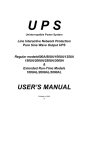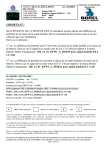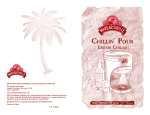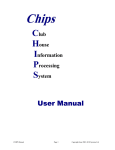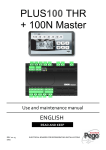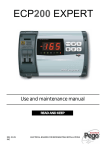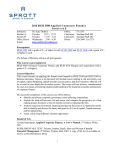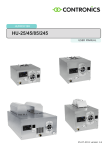Download DOUGH FEEDER WITH CONVEYOR BASKET MP10C
Transcript
DOUGH FEEDER WITH CONVEYOR BASKET MP10C - MP12C - MP15C - MP20C Manual for Installation, Use and Maintenance MPC-01-08-GB 1 GENERAL INDEX INTRODUCTION.........................................................................................................................................3 CORRESPONDENCE WITH THE MANUFACTURER............................................................................3 CE LABEL.....................................................................................................................................................3 SAFETY SIGNS............................................................................................................................................3 HAZARD.............................................................................................................................................3 PROHIBITED......................................................................................................................................3 OBLIGATORY....................................................................................................................................3 TECHNICAL DATA.....................................................................................................................................4 ENVIRONMENTAL CONDITIONS AND NOISE.....................................................................................4 RECOMMENDED USE AND PRECAUTIONS.........................................................................................5 MATERIALS TO BE USED.........................................................................................................................5 TRANSPORT, MOVING AND STORAGE.................................................................................................5 PROPER PLACEMENT AND POSITIONING DURING PROCESSING.................................................6 COMBINING MACHINES WITH LATERAL SLIDING GUIDE....................................................6 COMBINING MACHINES RESTING ON FEET..............................................................................6 ELECTRICAL CONNECTION....................................................................................................................6 RESIDUAL RISKS.......................................................................................................................................7 COMMANDS................................................................................................................................................8 USING THE MACHINE...............................................................................................................................8 FEEDING THE DOUGH.....................................................................................................................8 START-UP...........................................................................................................................................8 NORMAL STOP..................................................................................................................................8 EMERGENCY STOP..........................................................................................................................8 UNLOADING......................................................................................................................................8 PROGRAMMER..................................................................................................................................8 SLIDING THE DOUGH FEEDER LATERALLY.............................................................................9 SAFETY DEVICES ......................................................................................................................................9 OUT OF ORDER (ISOLATION)..................................................................................................................9 MAINTENANCE........................................................................................................................................10 CLEANING THE MACHINE...........................................................................................................10 CLEANING SURFACES UNDER THE MACHINE.......................................................................10 ORDINARY MAINTENANCE.........................................................................................................10 PROBLEMS, CAUSES AND REMEDIES................................................................................................10 FIGURE 1 - CE LABEL..............................................................................................................................11 FIGURE 2 - TRANSPORT AND MOVING..............................................................................................12 FIGURE 3 - PROPER PLACEMENT AND POSITIONING DURING PROCESSING...........................13 FIGURE 4 - COMBINING MACHINES....................................................................................................14 FIGURE 5 - RESIDUALS DANGERS.......................................................................................................15 FIGURE 6 - SAFETY SWITCHES.............................................................................................................16 FIGURE 7 - MACHINE..............................................................................................................................17 FIGURE 8 - COMMANDS.........................................................................................................................18 ALLEGATI FUNZIONAL SCHEME PROGRAMMER MANUAL This version of the installation, use and maintenance manual describes the features of the machine in current production. The manufacturer reserves the right to change and/or restructure the product and its technical and commercial documentation without any obligation to third parties. MPC-01-08-GB 2 INTRODUCTION This manual for the installation, use and maintenance pertains to the following models: DOUGH FEEDER WITH BASKET CONVEYOR BASKET MP10C - MP12C - MP15C - MC20C In this manual all the operations entailed in the normal use, service or repair of this model have been taken into account. We strongly urge users not to carry out any type of repair, operation or change that is not included in this manual. Only the manufacturers’ authorized technicians or technicians specially trained by the manufacturer possess the proper knowledge of the machine, equipment and have the experience to carry out any operation with the proper techniques. CORRESPONDENCE WITH THE MANUFACTURER The manufacturer’s name can be found on the CE label (Figure 1). Should the user need to contact the supplier regarding the purchased machine, s/he should always provide the following information: Type of machine Registration number Year manufactured Date of purchase Detailed description of problems encountered CE LABEL The label with the CE brand can be found in Figure 1. This contains the main information regarding the manufacturer, the machine and the registration number. SAFETY SIGNS HAZARD This sign indicates a hazard that could cause injury to persons. Please adhere strictly to the instructions provided. PROHIBITED This sign indicates that it is prohibited to carry out operations. Please adhere strictly to the instructions provided. OBLIGATORY This sign indicates an obligatory task required before proceeding. Please adhere strictly to the instructions provided. MPC-01-08-GB 3 TECHNICAL DATA TECHNICAL DATA Hopper capacity Maximum piece mass Maximum piece size Loading height Unloading height Overhang length Length Width Height Mass Tension Frequency Phases Breaker motor Basket motor Power supply Total Power / Current Operating temperature U.M. lt kg mm mm mm mm mm mm mm kg V Hz n° kW/A kW/A kW/A kW/A °C MP10C 200 - 500 10 d.170x450 1250 - 1800 1100 - 2500 500 - 2000 2060 - 3560 950 - 1070 1630 - 2930 400 - 650 230-400±10% 50 3 1.1 / 4.7-2.7 0.55 / 2.7-1.6 0.12 / 0.5-0.2 1.77 / 7.9-4.7 +5 ÷ +40 MP12C 200 - 500 12 d.200x350 1250 - 1800 1100 - 2500 500 - 2000 2060 - 3560 950 - 1070 1630 - 2930 400 - 650 230-400±10% 50 3 1.1 / 4.7-2.7 0.55 / 2.7-1.6 0.12 / 0.5-0.2 1.77 / 7.9-4.7 +5 ÷ +40 MP15C 200 - 500 15 d.200x450 1250 - 1800 1100 - 2500 500 - 2000 2060 - 3560 950 - 1070 1630 - 2930 400 - 650 230-400±10% 50 3 1.1 / 4.7-2.7 0.55 / 2.7-1.6 0.12 / 0.5-0.2 1.77 / 7.9-4.7 +5 ÷ +40 MP20C 260 - 530 20 d.200x600 1250 - 1800 1100 - 2500 500 - 2000 2060 - 3560 1100 - 1220 1630 - 2930 450 - 700 230-400±10% 50 3 1.1 / 4.7-2.7 0.55 / 2.7-1.6 0.12 / 0.5-0.2 1.77 / 7.9-4.7 +5 ÷ +40 ENVIRONMENTAL CONDITIONS AND NOISE There are no special conditions required for locating the machinery. In the most extreme conditions the noise level is lower than 75 db(A). The noise level indicated is the emission level and is not necessarily a safe operating level. Nevertheless, there is a relationship between levels of emission and levels of exposure, and this is a reliable indicator of whether further precautions are necessary or not. The factors that determine workers’ level of exposure include the duration of exposure, type of work place, other sources of dust and noise, etc., as well as the number of adjacent machinery and other processes. In addition, allowable levels of exposure can vary from country to country. In any case, this information allows the machinery user to better evaluate the dangers and risks. The sound emission level depends on where the machine is located as well as proper maintenance of all its parts. Test method: according to EN 23746 standards MPC-01-08-GB 4 RECOMMENDED USE AND PRECAUTIONS This machine was built to be used in bakeries and pastry shops, using exclusively layers of dough composed of the materials listed below and adhering to the requirements regarding safety, use and maintenance contained in this manual. The machine should not be used in unsuitable spaces or with improper materials and the personnel assigned to maintain it should have the proper training to use and maintain the machine, and should be the minimum age as required by the current laws in the country in which it is being used. Individual protection devices should be used and precautionary measures taken as indicated in this manual. It may be necessary to use other safety measures depending on working conditions. It is strictly forbidden to use this machine for operations other than those described herein, or make changes to the machine without prior agreement with the manufacturer. Staying safe depends mostly on you, the user. One should always be aware that there are risks entailed in using any machine. Before beginning any process, concentrate all your attention on what you are about to do. The work place should be very clean, free of obstacles and well lit with stable conditions of humidity and temperature. General cleanliness is a factor which regards safety and hygiene, so keep the machine well cleaned without using tools that may scratch it. Use of safety devices is strictly required, and they should never be disassembled or tampered with. The manufacturer will not be liable for an alteration or non-use of safety devices (fixed or movable guards, micro-switches, limit switches). MATERIALS TO BE USED Use only bread dough or pastry products composed of: A. Flour in its various types B. Water C. Yeast, fats, butter D. Sugar E. Aromas F. Salt G. Liqueurs and other components used to make dough for bread and pastry products TRANSPORT, MOVING AND STORAGE Check the total mass of the machine on the label and use proper equipment to move it. The machine will be delivered wrapped in extensible film and PVC tape to protect it from scratching during transport. We recommend not taking off the wrapping until the machine is ready to be started up, so as to maintain the proper conditions for good mechanical and electrical maintenance. To move the machine, use ropes that are adequate for the machine’s mass, hooked to two eye bolts situated on the upper part of the frame (Figure 2, A). Ensure that the angle formed by the ropes is less than 90°. Do not use pointed tools in order to avoid scratching the machine while unwrapping. Packaging materials should be disposed of in accordance with current laws. MPC-01-08-GB 5 PROPER PLACEMENT AND POSITIONING DURING PROCESSING Place the machine in the proper position depending on working needs, and specifically taking into account the diagram (Figure 3) which best interprets safety needs in relation to accident prevention experiences and studies. Particular attention should be paid to the most convenient electricity connection, and machine loading and unloading. Make sure the flooring is solid and even, so that the machine has a uniform base. Ensure a free area around the machine so as to allow for proper maintenance and cleaning (500mm). The proper position during processing is indicated. COMBINING MACHINES WITH LATERAL SLIDING GUIDE Rigidly affix the guide (Figure 4, A) to the coupled machine (Figure 4, B). Check to make sure that with the machine in operating position, there is no more than 10mm space between the second machine’s hopper and the dough feeder (Figure 4, C). If the space exceeds 10mm, fixed protection is needed to reduce the space between the hopper and the dough feeder. COMBINING MACHINES RESTING ON FEET Connect the safety limit switch (Figure 4, D) so that when the second machine receiving the pieces is moved, the dough feeder can not function. Check to make sure that with the machine in operating position, there is not more than 10mm space between the second machine’s hopper and the dough feeder (Figure 4, C). If the space exceeds 10mm, fixed protection is needed to reduce the space between the hopper and the dough feeder. ELECTRICAL CONNECTION Hooking up electricity to the machine must be done by a specialized technician according to the pertinent regulations. Ensure that the electrical line has the proper dimensions to support the machine’s power (minimum section of electrical cable 2.5mm²) and check to make sure the cable tension corresponds to the one of the electrical label (Figure 1). Before hooking up, ensure that the electrical line is not live. Insert the plug (Figure 7, B) in an interlocked socket that is properly equipped with 16A delayed fuses. Once hooked up, turn on the electricity with the socket’s switch and move the machine’s general switch (Figure 8, A) from position “0” to position “1”. If the machine needs to be slid laterally, place the feeder cable (Figure 7, A) so that the machine is free to slide in its runners (Figure 7, C) without being damaged. Do not touch the machine with wet or damp hands. MPC-01-08-GB 6 RESIDUAL RISKS This machine was designed and built with the intention of eliminating the risks deriving from its use. Nevertheless, during processing operators will be exposed to some residual risks, which due to the type of machine and its operations, can not be totally eliminated. In order to reduce residual risks to a minimum, operators must be properly instructed. This means reading this user and maintenance manual and scrupulously adhering to the safety instructions found on the machine in the form of hazard, prohibition and obligatory signs. Danger of upper limbs being crushed in the dough unloading area (Figure 5). In the installation phase of the machine, please ensure that the free area between the dough feeder and the coupled machine is less than 10mm (Figure 4, C). Danger of tripping. If the machine has to be slid laterally, please do not leave the guide in (Figure 7, C) in the open position. Open only when the machine needs to be moved to the cleaning position and close it when the machine is in operating position. Danger of entanglement or dragging of clothing or personal items. To ensure personal safety, before starting work, firmly secure sleeves around wrists, remove ties, keep hair out of the way with the proper implements, remove rings, wristwatches, bracelets, and any other object that could become entangled in the machine. Danger of crushing of limbs. If the machine is to be slid laterally, please ensure that the wheel stopper (Figure 7, D) has been inserted. Danger of inhaling flour dust while processing dough. Use only the necessary quantities during processing in order to avoid dispersing it into the atmosphere. Dangers of electrical nature. Switch off power to the machine when approaching the area marked with this sign. Ensure that the machine is hooked up with the proper plug (Figure 7, B) to a valid grounded installation, equipped with efficient ground plates. The grounding line must be checked by a specialized installer with special tools. MPC-01-08-GB 7 COMMANDS Commands are found in Figure 8: A. B. C. D. E. General switch Start button machine - Voltage light on /machine turned on (bright light) Stop button machine Emergency stop button Programmer USING THE MACHINE Do not allow the machine to be used by children or unauthorized persons. Before starting the work cycle, check that the machine is stable, properly hooked up to energy sources and that it is scrupulously clean. FEEDING THE DOUGH Put the dough in the hopper (Figure 7, G) by hand or pour it from a mixer. Do not overload the tub, otherwise the machine will not work due to the electrical protection barriers being interrupted. START-UP The machine may be started only after closing the mobile protection (Figure 7, H) and unblocking the emergency stop button (Figure 8, D) and then pushing the start button (Figure 8, B). Hold the button down until “on” button (Figure 3, B) turns on (bright light). NORMAL STOP The machine is stopped normally by pushing the stop button (Figure 8, C), which will stop at the end of the cycle underway. If the button is held down for more than 2 seconds, the machine will stop immediately. EMERGENCY STOP In case of an emergency, push the emergency stop button (Figure 8, D). To restart you need to unblock this button by pulling it and reactivating the start-up phase. UNLOADING The machine will unload the product onto the connected machine. PROGRAMMER The programmer (Figure 8, E) is used to set up the machine’s functions. Please read the programmer user’s manual to use it. MPC-01-08-GB 8 SLIDING THE DOUGH FEEDER LATERALLY To move the machine to cleaning position, open the machine slide guide (Figure 7, C), keep the work position stoppage unblocked (Figure 7, D) and move the machine by the handles (Figure 7, F) to the end of the guide and hook the cleaning position stop (Figure 7, E). The machine will not be able to work in this position. To bring the machine back to its working position, do the operation in reverse order. SAFETY DEVICES This machine has been engineered to CE safety standards. The safety switches (Figure 6, A) located in the mobile protection devices make it possible to start the machine only when they are closed. If it is necessary to slide the dough feeder laterally, the safety switch (Figure 6, C) acts on the guide, making it possible to start the machine only when it is in working position. If the machine is resting on its feet, the safety switch (Figure 6, D) acts on the connected machine, allowing the dough feeder to be started only when it is in working position. If you access the hopper while the cutter is working, the safety barrier (Figure 6, B) blocks it. If you push the emergency button or there is a power outage, the machine will not work until the start-up phase is re-activated with the control board. Safety devices must not be damaged or tampered with. OUT OF ORDER (ISOLATION) Separate the machine from electricity sources, taking the precaution of locking the general switch (Figure 8, A). Carry out a check of the operation with proper, precise means. One person should be responsible for these operations. If the operation is simple, this can be the person using the machine. If the machine is out of order due to breakage, repairs or in any case is not working safely, this should be displayed on the machine with a sign. Do not carry out any repairs, operation or change of any type except for those indicated in this manual. Only technical personnel authorized or trained by the manufacturer have the necessary knowledge of the machine, equipment and experience to do any operation with the proper techniques. MPC-01-08-GB 9 MAINTENANCE Before proceeding with any sort of maintenance, turn off the electricity to the machine. As the machine processes food products, precise, daily cleaning is what will ensure the best performance. General cleaning of the machine and the surrounding flooring is an important safety factor. Never repair, register, operate, lubricate or clean parts that are working. Do not carry out any repairs, operations or changes of any type except for what is indicated in this manual. Only technical personnel authorized or trained by the manufacturer have the necessary knowledge of the machine, equipment and experience to do any operation with the proper techniques. CLEANING THE MACHINE The machine should be cleaned daily. The body of the machine and parts that come in contact with food should be cleaned only with a sponge soaked with water. Use compressed air and an aspirator to clean the less accessible areas. We recommend dismantling all the fixed protection once every six months to carefully clean all the areas that are not normally accessible. CLEANING SURFACES UNDER THE MACHINE If the dough feeder slides laterally, it is necessary to move the machine to clean this area. If the machine rests on its feet, there is enough space underneath to clean properly. ORDINARY MAINTENANCE Interval Maintenance to be done 500h Check the basket chain and clean and adjust tension with a chain tightener as needed (Figure 7, I). 1000h Check the cutter chain and adjust tension with a chain tightener as needed (Figure 7, K). 2000h Check basket bolts and clean as needed (Figure 7, J). 2000h Check breaker bearings and lubricate with grease as needed (Figure 7, L). PROBLEMS, CAUSES AND REMEDIES Problem Possible cause The machine does not start and No power in the socket. the voltage light is off. Plug is not inserted. General switch is not turned on. The QF0 thermal protection on VC1 power supply is in block. VC1 power supply is broken. Remedy Check the socket and its fuses. Insert the plug. Turn on the general switch. Open the control board and reset it. Replace the power supply. For other problems refer to the messages on the programmer (Figure 8, E) and the attachment “Programmer user’s manual”. MPC-01-08-GB 10 FIGURE 1 - CE LABEL MPC-01-08-GB 11 FIGURE 2 - TRANSPORT AND MOVING MPC-01-08-GB 12 FIGURE 3 - PROPER PLACEMENT AND POSITIONING DURING PROCESSING MPC-01-08-GB 13 FIGURE 4 - COMBINING MACHINES MPC-01-08-GB 14 FIGURE 5 - RESIDUALS DANGERS MPC-01-08-GB 15 FIGURE 6 - SAFETY SWITCHES MPC-01-08-GB 16 FIGURE 7 - MACHINE MPC-01-08-GB 17 FIGURE 8 - COMMANDS MPC-01-08-GB 18



















